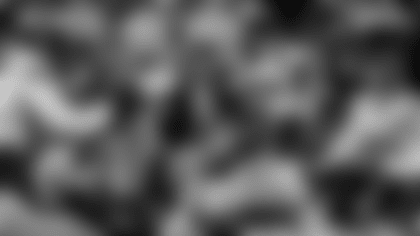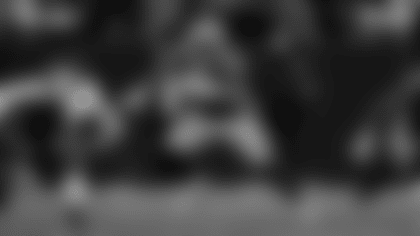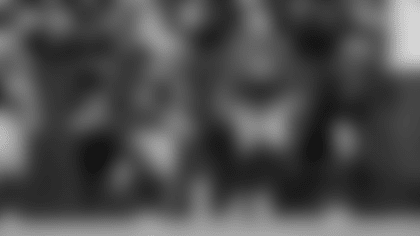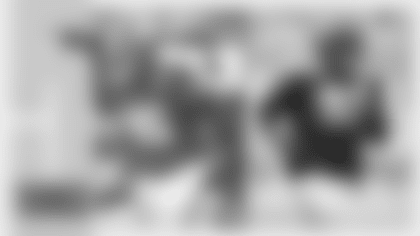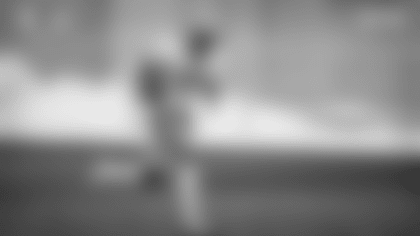The Packers' offseason strength and conditioning program just completed its fifth week, with players scheduled to take this week off before returning for another four-week stretch.
To give fans a glimpse into the weight room and a look at how one of the team's key players prepares himself for the upcoming season, Packers.com chronicled -- diary-style and with accompanying video highlights -- one workout of running back Ryan Grant last week.
Some of the lifts and exercises may seem a bit unconventional, but that's a reflection of how Grant tailors his workout to his position and its physical demands.
"I do a lot of different stuff than the norm, try to change things up with my exercises and try to hit the muscles differently," Grant said. "I want it to be related and movement-based to what I do on the field."
So here's his workout from start to finish, with comments from a post-workout interview with Grant spliced in where appropriate:
10:05 a.m. (gymnasium)
After receiving instructions from strength and conditioning coordinator Mark Lovat on the five-minute warm-up exercises for the day, Grant begins a series of exercises that includes lateral step-overs, shuffles, medicine balls throws, step-to-jump-ups, side lunges, and medicine ball raises from a lunging position. Then it's off to the weight room, grabbing a bottle of water along the way.
10:11 a.m. (weight room)
He starts with squats. First, it's a warm-up set of five reps at 135 pounds. Then Lovat adds resistance bands to the bar. The bands hook around the ends of the barbell where the weights are stacked and are secured to the base of the squat rack. With the bands not at full tension, Grant does a warm-up set of five reps at 185 pounds.
Then things get tougher. The bands are adjusted to a stronger tension, and Grant begins trading sets with defensive back Derrick Martin. A set of five reps at 225 pounds, followed by another set at 275. After each set, Grant does a series of two-foot jumps onto a three-foot-high ledge to keep his legs loose, and works in some sips of water as well.
"I squatted today with the bandwork to try and change it up a little bit," Grant said. "You drop down on the weight a little bit but you do a little bandwork for resistance, to get more of a 'pop.' I've been trying to do it the last couple weeks with chains and bands."
The last set is four reps at 315 pounds, with a spot from strength and conditioning assistant Thaddeus Jackson. As he heads over to his next exercise, Grant catches a glimpse of offensive lineman Evan Dietrich-Smith squatting 455 pounds on a free bar. How close 315 with the resistance bands comes to that isn't clear.
"I don't know exactly how much weight (it adds), but it's definitely resistance," Grant said of the bands. "You can ask Derrick Martin. I try to bring some of the other guys along and do certain things with me, and they usually don't like it. They like what they get out of it, but they don't like how it feels.
"It's different. You have to stabilize more, because you have rubber bands pulling you down and everything, so you really have to have control. When you squat and have control, a lot of it has to do with your core strength. Every exercise you do, you want to be in control. It works that explosion and works that control and that power, which is my job, being able to explode up and control it down.
"I have to be able to be stabilized when people hit me and jump on my back and tackle me and all that, and at the same time be able to explode through and burst out of those tackles."
10:26 a.m.
Next up is the incline bench press. Getting a spot from fellow running back Brandon Jackson, Grant does two sets of six reps each at 225 pounds. In between and after, he lays down flat on his back, with a strength assistant standing on an elevated ledge above him, throwing a medicine ball down at his chest. Grant has to catch the medicine ball and fire it straight up. Two sets of 10 throws each.
Then, in between doing some stretching exercises for his shoulder along the wall and with an exercise ball, Grant works in a quick set on a standing leg-press machine with a chain/pulley system. There appears to be around 200 pounds of weight added to the machine, and Grant does one-legged squats, five on each leg.
10:40 a.m.
Grant throws on two weighted vests and grabs a pair of 30-pound dumbbells. He takes 12 lunging strides through the middle of the weight room, stops to do some more stretching on an exercise ball, and then does 12 more lunging strides, this time with 40-pound dumbbells in addition to the weighted vests.
10:48 a.m.
Next, an alternating series of two exercises. For the first, Grant balances on one leg on a half-ball base. With a 40-pound dumbbell in one hand, he bends over and straightens up again, maintaining his balance for five reps on each leg.
"For me, a lot of positions I'm in are off-balance positions," Grant said. "So I need to do a lot of things that help stabilize my core and improve my balance and make sure that I'm strong off-balance. I want to be mobile and strong in unbalanced states. So I do a lot of single-leg stuff, a lot of single-leg dumbbell exercises."
He alternates those sets with a set on what can best be described as an inverted or reverse sit-up machine. With his stomach facing the ground, Grant locks his legs into the machine and proceeds to lower his torso from being perpendicular to the ground to being parallel, and then back up again, seven times in all. It looks excruciatingly difficult.
"It's called glute-ham, which means your glutes and your hamstrings," Grant said. "It's tough and it's all about control as well. You can change it up a little bit with your hands. Sometimes I had my hands out (in front), sometimes my hands (were by the head). It just changes the exercise a little bit, makes it a little harder. You literally can feel that isolate on your hamstrings and your butt.
"You get that pain, that burn, but it's a good burn."
Working in some hamstring stretches here and there, Grant goes back to the balance half-ball and does five more reps on each leg, with 45-pound dumbbells this time. Then it's back to glute-ham for seven reps. His last sets on the half-ball are with 50-pound dumbbells, followed by one more set of seven on glute-ham.
At this point, Grant takes about a five-minute break for some water and a brief chat with offensive tackle Chad Clifton.
11:04 a.m.
Back to some more bench work, this time with dumbbells. Grant does 10 reps with 95-pound dumbbells and then another set of 10 with 100-pounders. In between and after, he does some more shoulder work with the training staff, sitting against a wall and pushing straight up against some resistance. One of the exercises is done by holding a stick in both hands above his head.
"I make sure to do the pre-hab and rehab stuff, just keeping the little muscles in my shoulders strong," Grant said. "We do a lot of different exercises that don't look that bad, but trust me, they hurt, with no weight."
11:20 a.m.
Medicine ball work. With Thaddeus Jackson assisting, Grant does a set of 15 sit-ups while a medicine ball is thrown at his chest, requiring him to fire it back with a two-hand chest pass. On his next set of 15 sit-ups, he catches the medicine ball and then throws it back two-handed from above his head.
Next, sitting down while keeping his legs extended but above the ground, Grant lofts the medicine ball 15 times off his left hip, with Jackson catching it and tossing it back. Then it's 15 off the right hip.
For the last two sets, Grant is lying on his back. He puts the medicine ball between his feet and raises it up to Jackson, who is standing behind his head and pushes his legs back down. After 15 of those, Jackson moves to the area beyond Grant's feet and soft-tosses the medicine ball as Grant kicks it back, two-footed, 15 times.
Another water break and some stretches for his back precede the final portion of the workout.
11:30 a.m.
The jump rope finishes things up. Switching up between jumping with both feet, one at a time, alternating, side to side, etc., Grant jumps a sequence of four rounds of 30 seconds on, 30 seconds rest. Getting sips of water in between, he does two more sequences of four rounds apiece.
"That's a little cardio," Grant said. "You get out of it what you put into it. For me, the jump rope is something to help improve foot speed, make myself quicker, especially for my position. I try to incorporate different drills. I was acting like I was jumping around the box, do high knees, jump rope one foot, back and forth, quarter turns, ... different things to try to incorporate some other types of conditioning drills we do.
"I try to push myself as much as possible on the jump rope, so that I come out exhausted regardless. If I hit the rope, I get right back into it, which is hard. That makes you tired as well. Because when you hit the rope, it drains you a little bit like that.
"But I like it, because I think it does improve foot speed. I think jumping rope is one of the best places to make yourself quicker, make your feet quicker."
11:45 a.m.
Grant is done for the day, and makes his way over to the break area where he drops a banana, some water and protein powder into a blender for a post-workout smoothie.
"A little whey protein, nothing special," he said. "Just a little whey protein to help rebuild what I just ripped up during that workout, to help myself recover a little quicker."
The next workout is coming the very next day.


